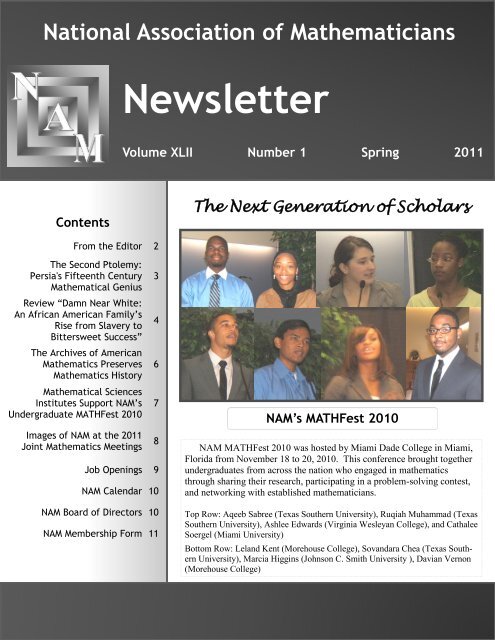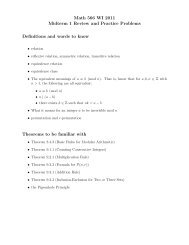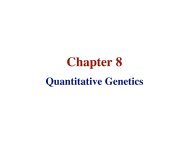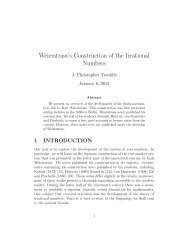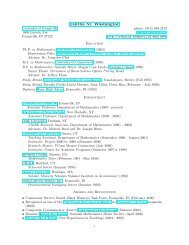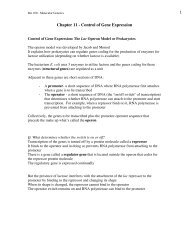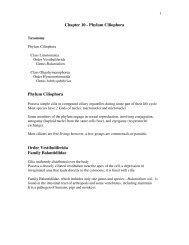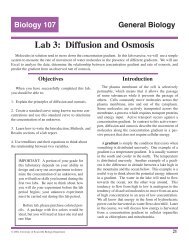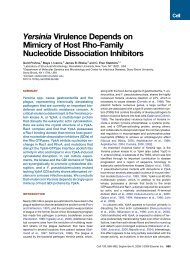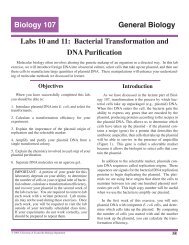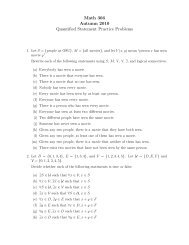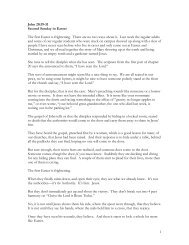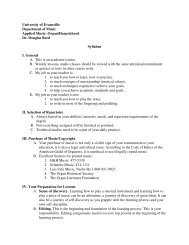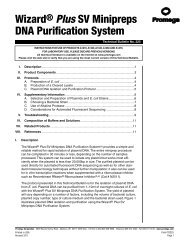NAM Newsletter - University of Evansville
NAM Newsletter - University of Evansville
NAM Newsletter - University of Evansville
Create successful ePaper yourself
Turn your PDF publications into a flip-book with our unique Google optimized e-Paper software.
Spring 2011National Association <strong>of</strong> Mathematicians<strong>Newsletter</strong>Volume XLII Number 1 Spring 2011ContentsThe Next Generation <strong>of</strong> ScholarsFrom the Editor 2The Second Ptolemy:Persia's Fifteenth CenturyMathematical GeniusReview “Damn Near White:An African American Family’sRise from Slavery toBittersweet Success”The Archives <strong>of</strong> AmericanMathematics PreservesMathematics HistoryMathematical SciencesInstitutes Support <strong>NAM</strong>’sUndergraduate MATHFest 2010Images <strong>of</strong> <strong>NAM</strong> at the 2011Joint Mathematics Meetings34678Job Openings 9<strong>NAM</strong> Calendar 10<strong>NAM</strong> Board <strong>of</strong> Directors 10<strong>NAM</strong> Membership Form 11<strong>NAM</strong>’s MATHFest 2010<strong>NAM</strong> MATHFest 2010 was hosted by Miami Dade College in Miami,Florida from November 18 to 20, 2010. This conference brought togetherundergraduates from across the nation who engaged in mathematicsthrough sharing their research, participating in a problem-solving contest,and networking with established mathematicians.Top Row: Aqeeb Sabree (Texas Southern <strong>University</strong>), Ruqiah Muhammad (TexasSouthern <strong>University</strong>), Ashlee Edwards (Virginia Wesleyan College), and CathaleeSoergel (Miami <strong>University</strong>)Bottom Row: Leland Kent (Morehouse College), Sovandara Chea (Texas Southern<strong>University</strong>), Marcia Higgins (Johnson C. Smith <strong>University</strong> ), Davian Vernon(Morehouse College)<strong>NAM</strong> <strong>Newsletter</strong> 1
Volume XLII Number 1The National Association <strong>of</strong> Mathematicians (<strong>NAM</strong>)publishes the <strong>NAM</strong> <strong>Newsletter</strong> four times per year.EditorDr. Talitha M. Washington<strong>University</strong> <strong>of</strong> <strong>Evansville</strong>nam_newsletter@yahoo.comhttp://faculty.evansville.edu/tw65/Editorial Board Find <strong>NAM</strong> <strong>Newsletter</strong>Dr. Edray Herber Goinson Facebook!Purdue <strong>University</strong>egoins@math.purdue.eduhttp://www.math.purdue.edu/~egoins/Dr. Mohammad K. Azarian<strong>University</strong> <strong>of</strong> <strong>Evansville</strong>azarian@evansville.eduhttp://faculty.evansville.edu/ma3/<strong>Newsletter</strong> Websitehttp://faculty.evansville.edu/tw65/<strong>NAM</strong>.htmThis website has a list <strong>of</strong> open job and summer positions.It also features past editions <strong>of</strong> the <strong>Newsletter</strong> and editionsfrom 41.1 to present are in color.From the EditorAs I sit in church, I can hear the constant babbling <strong>of</strong>babies and the wild chatter <strong>of</strong> children. I admit that sometimesI am disquieted as I am trying to hear the stories beingtold. All <strong>of</strong> the sudden, my pastor, Rev. Adrian M.Brooks, Sr., interrupts his message to remind us that ―youknow when an organization is alive. You see and hear theyouth. A dying organization is void <strong>of</strong> the young.‖<strong>NAM</strong>‘s efforts to cultivate, nourish and grow the nextcrop <strong>of</strong> mathematical researchers are highly commendable.At <strong>NAM</strong>‘s Undergraduate MATHFest 2010, budding students,intrigued by the rigor and beauty <strong>of</strong> mathematics,gained invaluable connections (page 7). At the Joint MathematicsMeetings 2011, the new Ph.D. session showeddiversity within areas <strong>of</strong> research, as well as diversitywithin the <strong>NAM</strong> community (page 8). All the while, Dr.Azarian reminds us that, as we move forward, it is vital topreserve our past, and remember the mathematicians whocame before us (page 3). We are also encouraged to preserveour own works, and Carol Mead <strong>of</strong> the Archives <strong>of</strong>American Mathematics Archives shows us how (page 6).Fortunately, at times, a family member will document thejoys and conflicts that exist in every family, as with Dr. J.Ernest Wilkins‘ family (page 4).Letters to the editor should be addressed to Dr. TalithaM. Washington, <strong>University</strong> <strong>of</strong> <strong>Evansville</strong>, Department <strong>of</strong>Mathematics, 1800 Lincoln Avenue, <strong>Evansville</strong>, Indiana47722 or by email to nam_newsletter@yahoo.com.Email is preferred.Subscription and membership questions should bedirected to Dr. Roselyn E. Williams, Secretary-Treasurer,National Association <strong>of</strong> Mathematicians, P.O. Box 5766,Tallahassee, Florida 32314-5766; (850) 412-5236; email:Roselyn.Williams@famu.edu<strong>NAM</strong>’s Official Webpage http://www.nam-math.org<strong>NAM</strong>’s History and Goals: The National Association<strong>of</strong> Mathematicians, Inc., known as <strong>NAM</strong> was founded in1969. <strong>NAM</strong>, a nonpr<strong>of</strong>it pr<strong>of</strong>essional organization, hasalways had as its main objectives, the promotion <strong>of</strong> excellencein the mathematical sciences and the promotion andmathematical development <strong>of</strong> under-represented minoritymathematicians and mathematics students. It also aims toaddress the issue <strong>of</strong> the serious shortage <strong>of</strong> minorities inthe workforce <strong>of</strong> mathematical scientists.David Bressoud (MAA President2009-2010) and Talitha WashingtonHowever,we do nothave to proceedby ourselves.Overthe years, wehave receivedgenerous supportfor ourefforts fromthe mathematicsinstitutesfrom across the country (page 7). Through connectionswith other pr<strong>of</strong>essional organizations such as theMathematical Association <strong>of</strong> America, our efforts are supportedand amplified.As <strong>NAM</strong> proceeds forward, we are reminded to includethe young, to make connections with those aroundus, and to provide both the courage and support to moveour community forward so that the next generation <strong>of</strong>scholars can travel a smoother road that leads to mathematicalgreatness.Enjoy!2<strong>NAM</strong> <strong>Newsletter</strong>
Spring 2011The Second Ptolemy: Persia's Fifteenth CenturyMathematical GeniusMohammad K. AzarianGhiyāth al-Dīn Jamshīd Masūdal-Kāshī was one <strong>of</strong> the most renownedmathematicians and astronomersin Persian history, as well asone <strong>of</strong> the most fascinating medievalmathematicians in the world. InIran and other Persian speaking societies,he is called by his PersianMohammad Azarian name, Kāshānī. Kāshānī‘s exactdate <strong>of</strong> birth is not known, but it was sometime during thesecond half <strong>of</strong> the fourteenth century. Most likely, he wasborn in the Tamerlane empire in the city <strong>of</strong> Kāshān in centralIran about 160 miles south <strong>of</strong> the capital Tehran, andabout 300 miles from the Caspian Sea. Kāshānī died onthe morning <strong>of</strong> Wednesday, June 22, 1429 (Ramadān 19,832 AHL) outside <strong>of</strong> Samarqand, at the observatory he hadhelped to build in Uzbekistān, in northeast Iran.Kāshānī was known for his extraordinary ability toperform very difficult mental computations. The manynicknames given to Kāshānī include ―the second Ptolemy‖,―the pearl <strong>of</strong> the glory <strong>of</strong> his age‖, ―the king <strong>of</strong> engineers‖,―the reckoner‖, and ―our master <strong>of</strong> the world‖.Although Kāshānī‘s interests were in mathematics andastronomy, he was actuallya physician. Like manyother scientists <strong>of</strong> theMiddle Ages, he dedicatedmost <strong>of</strong> his known scientifictreatises to monarchsor other influentialrulers <strong>of</strong> his time in orderto receive compensation.Kāshānī was Persian,but, in order to increasehis readership, he wrotemost <strong>of</strong> his mathematicalwork in Arabic. Most <strong>of</strong>his work was written insexagesimal system, asystem where the digitsare separated by commas, and the integral and fractionalparts by semicolons. (For example, ―1, 23; 45, 57‖ in base60 is1 × 60 + 23 × 60 0 + 45 × 60 -1 + 35 × 60 -2 in base 10.) Today,his best-known work has been translated into English,French, German, and Russian. For a more detailed discussion<strong>of</strong> Kāshānī‘s life and his mathematical achievements,we refer the reader to the references provided for this article,especially [5].Mathematical Achievements―The Treatise on the Circumference‖ was completedin Arabic as Al-Risāla al-muhītīyya in July <strong>of</strong> 1424(Sha‘bān 827 AHL). In this masterpiece <strong>of</strong> computationaltechniques, Kāshānī used his fundamental theorem fromthis risāla to calculate the value <strong>of</strong> Л, correct to 16 decimalplaces. He used inscribed and circumscribed polygons,each with 805,306,368 sides. This approximation <strong>of</strong>Л was a remarkable achievement for that time. It far surpassedall approximations <strong>of</strong> Л by all previous mathematiciansthroughout the world, including Archimedes, Ptolemy,and Muhammad al-Khwārizmī. Archimedes‘ approximationwas 3.14 (250 BC); Ptolemy‘s result was 3.14166(150 AD); and al-Khwārizmī‘s approximation was 3.1416(800 AD). It took European scientists 186 years to improveon Kāshānī‘s approximation <strong>of</strong> Л.―The Treatise on the Chord and Sine‖ was completedin Arabic as Risāla al-watar wa’l-jaib around 1427. Themain part <strong>of</strong> this work involves the creation <strong>of</strong> and solutionsto the cubic equation ax = b + x 3 where a and b areconstants. He then found an approximation <strong>of</strong> sin 1 o viatrigonometric identity sin 3x = 3sin x - 4sin 3 x. By usingan iterative method, today known as the fixed-point method,he found thatsin 1 o = .0174524064372835103712which is correct to 22 decimal places (and is equivalent tosin 1 o = 1;2,49,43,11,14,44,16,26,17, correct to ten sexagesimalplaces). This was the first approximation methodin the history <strong>of</strong> mathematics and the most significantachievement in medieval algebra. Before this work, thebest known approximation was found in the tenth centuryAD by Abu‘l-Wafā and Ibn Yūnus but they were correct toonly four sexagesimal places.―The Key <strong>of</strong> Arithmetic‖ or ―The Calculators‘ Key‖was completed in Arabic as Miftāh al-hisāb on March 2,1427 (Jamādi al-awwal 3, 830 AHL). It took Kāshānīmore than 7 years to complete this work. It was writtenprimarily as a textbook and was used for more than fivecenturies as a textbook as well as an encyclopedia. Itserved many generations <strong>of</strong> students, accountants, astronomers,architects, engineers, land surveyors, and merchants.Side NoteThe start <strong>of</strong> the Islamic calendar is the year 622 AD inthe Western calendar, the year the prophet Muhammadmade the hijra, his migration Mecca to Medina. There aretwo Islamic calendars in use: the lunar, which is 354 daysand the solar, which is 365 days. In this article, ―AHL‖and ―AHS‖ are used for these two calendars, respectively.<strong>NAM</strong> <strong>Newsletter</strong> 3
Spring 2011and emailed the author with some general comments. I amvery pleased to recommend this book. My copy has markings,comments, and underlined passages on almost everypage. This short history <strong>of</strong> the Wilkins family is an importantwork withinthe context <strong>of</strong>African Americanhistory and culture.In spite <strong>of</strong> beingbrief, the bookprovides a sensitiveand deep commentaryon what itmeans to hold distinguishedmembershipin theblack elite, inDr. Mickens discussing the book at theJMM 2011 <strong>NAM</strong> BusinessMeeting in New Orleanswhich, simultaneouslythe individualsare also ―damnnear white.‖Buy a copy, now!In our mathematics community, when the name Dr. J.Ernest Wilkins is called forth, we are generally referring toJ. Ernest Wilkins, Jr., a son <strong>of</strong> the J. Ernest Wilkins, who isthe subject <strong>of</strong> Damn Near White. J. Ernest Jr. is a distinguishedmathematician, engineer, science administrator,and mentor to many pr<strong>of</strong>essors and students. It is <strong>of</strong> significanceto note that his mother, Lucile Robinson, and fatherreceived undergraduate degrees in mathematics; the fatherfrom the <strong>University</strong> <strong>of</strong> Illinois (BS, 1918) and his mother atthe <strong>University</strong> <strong>of</strong> Chicago (BS, 19??).In addition to J. Ernest Jr., the Wilkins had two otherchildren, Julian and John. Both graduated from the LawSchool <strong>of</strong> Harvard <strong>University</strong>. The author‘s father, Julian,had a very successful career as an attorney, while Johnworked for the U.S. Justice Department in Washington,DC. For our purposes, it is <strong>of</strong> interest to know that CarolynWilkins‘ mother told her (pp. 33) that ―Lucile and J. Ernestwere hard on their children … Your father never felt hewas bright enough or good enough to suit either one <strong>of</strong>them.‖ Further, ―Both Aunt Constance and my mother describedJ. Ernest‘s criticism <strong>of</strong> his boys as ‗unrelenting,‘‗harsh,‘ and ‗extreme‘ (pp. 32). Even when they hadgrown to adulthood, J. Ernest rode his boys hard.‖My own deep personal and pr<strong>of</strong>essional relations with J.Ernest, Jr. began about 1988 when I initiated discussionswith him on accepting a pr<strong>of</strong>essorship at the then newClark Atlanta <strong>University</strong>, which was a consolidation <strong>of</strong>Atlanta <strong>University</strong> and Clark College. In 1990, he was appointedDistinguished Pr<strong>of</strong>essor <strong>of</strong> Applied Mathematicsand Mathematical Physics and retired from that position in2003.J. Ernest, Jr. was a very sociable person and on manyoccasions my wife and I enjoyed the warm and cozy atmosphere<strong>of</strong> his home, along with Sylvia (Spelman College)and Robert (Morehouse College) Bozeman. At othertimes, especially for lunch, Sandra Rucker (Clark Atlanta<strong>University</strong>) and Earl Barnes (Morgan State <strong>University</strong>)would be present.I had the opportunity on several occasions to formallyinterview J. Ernest, Jr. These sessions generally lasted forabout three hours and he provided me with a wide range <strong>of</strong>his views on subjects involving personal, private, and publicaspects <strong>of</strong> his careers, life, and wishes. A small part <strong>of</strong>my short bio-essay on him is based on my notes from thesediscussions. However, reading the book Damn Near Whiteallows me to place many <strong>of</strong> his replies to my questions in abroader perspective. In particular, I think I now understandhis general kindness and patience with both students andcolleagues, and why he was such a successful mentor toboth sets <strong>of</strong> individuals.Before I end, two ―stories‖ may be <strong>of</strong> interest to thereader. First, J. Ernest, Jr. once told me that during the review<strong>of</strong> one <strong>of</strong> his mathematics research manuscripts, theeditor wanted him to change only one word to have thepaper accepted for publication. He wrote back that hisword selection was the proper one to use and that if thesuggested change was required, he would withdraw themanuscript. Upon receipt <strong>of</strong> the editor‘s reply, he withdrewhis work from further consideration in that journal.The second ―story‖ involves me. For almost thirtyyears, I have taught a graduate course in mathematicalphysics. When J. Ernest, Jr. arrived at Clark Atlanta <strong>University</strong>,he would <strong>of</strong>ten stand outside my classroom andlisten to my lectures. On four or five occasions, severaldays later, he would produce a massive (~ 20 pages) documentgiving the full mathematical pro<strong>of</strong> details on sometopic that I had presented to my graduate students. Ofcourse, I always welcomed these results and for all <strong>of</strong> themwe jointly reworked them into papers emphasizing both themathematical and physical aspects <strong>of</strong> the topics. He enjoyedmy deep physical reasoning associated with theseproblems and I came to appreciate greatly the precision <strong>of</strong>his quick and sharp mind as it related to many areas <strong>of</strong> appliedmathematics. While these joint efforts generally wereon problems not before discussed in the research literature,we never published any <strong>of</strong> them. Maybe, this will be donein the near future.In summary, we should all thank Carolyn Wilkins forbringing to us the details <strong>of</strong> the Wilkins family history.Hopefully, someday soon, someone will write a fuller volumeon this remarkable family and give in detail their contributionsto help create a more humane and understandingAmerican society.Ronald Mickens is a Pr<strong>of</strong>essor <strong>of</strong> Physics at Clark Atlanta<strong>University</strong> and a life member <strong>of</strong> <strong>NAM</strong> . His email isrmickens@cau.edu.<strong>NAM</strong> <strong>Newsletter</strong> 5
6<strong>NAM</strong> <strong>Newsletter</strong>Volume XLII Number 1The Archives <strong>of</strong> American Mathematics PreservesMathematics HistoryCarol MeadDuring the January 2011 Joint Mathematics Meeting inNew Orleans, I had the good fortune to meet Dr. TalithaWashington, this newsletter's editor. When I told Talithawhat I do–preserve the papers <strong>of</strong> mathematicians and records<strong>of</strong> mathematics organizations at the <strong>University</strong> <strong>of</strong> Texasat Austin (UT)–we discovered a mutual interest: seeingmore underrepresented mathematicians preserve their papersfor future generations to research. She encouraged meto write an article about the collections I curate, with theaim <strong>of</strong> appealing to the <strong>NAM</strong> membership to preserve theirpapers for the historical record.What Is the Archives <strong>of</strong> American Mathematics?The mission <strong>of</strong> the Archives <strong>of</strong> American Mathematics(AAM), a research component <strong>of</strong> the Dolph Briscoe Centerfor American History (the Center) at UT, is to collect, preserve,and provide access to the records <strong>of</strong> American mathematiciansand mathematical organizations for use by historians,mathematicians, educators, and others interested inthe history and development <strong>of</strong> mathematics. Since its inception35 years ago, the AAM has grown from two toover 100 collections, housing the papers and records <strong>of</strong>prominent American mathematicians and organizations,including those <strong>of</strong> the MAA, for which we are the <strong>of</strong>ficialrepository for its historical records. In 2003, with the support<strong>of</strong> the MAA and the Educational Advancement Foundation,an Austin-based philanthropic organization, theCenter created a position unique in the United States: anarchivist dedicated to curating mathematics collections.Now, with a solid foundation <strong>of</strong> mathematical archivalcollections, the AAM‘s goal is to become the preeminentresource for the history <strong>of</strong> American mathematics. To accomplishthis goal, we must include mathematicians andorganizations from a wide range <strong>of</strong> the American mathematicscommunity, including underrepresented minorities.Why Preserve Papers?I have found, in talking with mathematicians, thatmany <strong>of</strong> you do not consider your papers to have archivalmerit. I would like to counter that belief by saying thatyour papers do have historical value. Whatever the subjectarea, including mathematics, archives can reveal, amongother things, the genesis and development <strong>of</strong> ideas and,ultimately, document the progress <strong>of</strong> a nation‘s intellectualgrowth. The papers <strong>of</strong> African American and other minoritymathematicians are <strong>of</strong> particular importance both for theideas found within them and for the evidence they provide<strong>of</strong> minorities‘ growing participation in and contributions tothe American intellectual record.I realize that generally mathematicians do not use archivesin their research, unless it tendsto the historical. However, ideas, inthis case mathematical ones, are notcreated in a vacuum. They have a historicaltrail, which <strong>of</strong>ten is found inCarol Meadmathematicians‘ papers – in notes or correspondence, forinstance. One example <strong>of</strong> this trail comes from a small collectionhere <strong>of</strong> notebooks created by G. A. Hedlund, <strong>of</strong>Yale, during World War II, and two letters between Hedlundand Marston Morse in 1941. According to the donor,one <strong>of</strong> Hedlund‘s Ph.D. students, the notebooks and one <strong>of</strong>the letters is likely the beginning <strong>of</strong> the symbolic logic anddiscrete dynamical systems as we know them today.How Do You Donate Papers or Records?To initiate a donation, please contact me atcarolmead@austin.utexas.edu. Information I will ask forincludes the background <strong>of</strong> the creator <strong>of</strong> the collection, thegeneral contents (pr<strong>of</strong>essional correspondence, lectures,etc.), volume, and formats <strong>of</strong> materials (paper, digital, photographs,etc.). I also request a general inventory <strong>of</strong> thecollection, which I use to determine what should be acceptedfor donation.Once we agree on the donation, the donor sends it tome and I then send the donor a Deed <strong>of</strong> Gift to sign and aletter <strong>of</strong> acknowledgment. Once the agreement is in place,we will ―process‖ the collection: establish an arrangementfor it, transfer the materials into archival quality foldersand boxes, create an online ―finding aid‖ (which containsbackground about the creator and the papers, and box contents),and store the boxes in our facilities. At this point,the collection is open to researchers.I encourage you to contact me if you have any questionsabout possible donations <strong>of</strong> collections, as well asinquiries about our research materials. For further informationabout the AAM, please visit our website:http://www.cah.utexas.edu/collections/math.php A listing<strong>of</strong> our collections and links to their inventories may also befound on the site: http://www.cah.utexas.edu/collections/math_findingaids.phpWhat is the Briscoe Center?The Dolph Briscoe Center for American History is aspecial collections library, archive, and museum that facilitatesresearch and sponsors programs on the history <strong>of</strong> theUnited States. The Briscoe Center supports research andeducation by acquiring, preserving, and making availableresearch collections and by sponsoring exhibitions, conferences,symposia, oral history projects, publications, andgrant-funded initiatives.
Spring 2011Nathaniel DeanThere are several institutes around thecountry that are at least partially fundedby the National Science Foundation(NSF). Eight <strong>of</strong> these institutes contributed$250 towards awards given to undergraduatepresenters at <strong>NAM</strong>‟s UndergraduateMATHFest, held from Novem-Dr. Nate Dean,<strong>NAM</strong> Presidentber 18-20, 2010 at Miami Dade College inMiami, Florida. These institutes are:American Institute <strong>of</strong> Mathematics (AIM)Institute for Computational and Experimental Researchin Mathematics (ICERM)Institute for Mathematics and its Applications (IMA)Institute for Pure and Applied Mathematics (IPAM)Mathematical Biosciences Institute (MBI)Mathematical Sciences Research Institute (MSRI)National Institute for Mathematical and BiologicalSynthesis (NIMBioS)Statistical and Applied Mathematical Sciences Institute(SAMSI)Students competed for cash prizes two separate competitions:oral presentations and problem solving. All studentswere allowed to compete in both competitions. Thejudges used a rubric with a detailed list <strong>of</strong> criteria to ensureconsistency. The actual scorecard was adapted by the authorfrom one used by the Society for the Advancement <strong>of</strong>Chicanos and Native Americans in Science (SACNAS) fora poster presentation competition at one <strong>of</strong> their conferences.Specifically, the judges evaluated each presentation‘scontent, organization, delivery, awareness <strong>of</strong> audience,quality <strong>of</strong> visual aids, and length <strong>of</strong> talk.Presentation Winners1 st PlaceRaymond Perkins, Pursuit Evasion Games on Graphs,SURIEM, Michigan State <strong>University</strong>Carol Mead is the Archivist for the Archives <strong>of</strong> AmericanMathematics, The Dolph Briscoe Center for American Historyat The <strong>University</strong> <strong>of</strong> Texas at Austin. Her email iscarolmead@austin.utexas.edu.Mathematical Sciences Institutes Support <strong>NAM</strong>’sUndergraduate MATHFest 2010Davian Vernon, ClassifyingBol-Moufang Quasigroupsunder a Single Operation,SUMSRI, Miami <strong>University</strong>2 nd PlaceAshlee Edwards andCathalee Soergel, The TravellingSalesman at HomeNear You, SUMSRI, Miami <strong>University</strong>Davian Vernon andRaymond PerkinsSam Somuah, Graph Mining, DIMACS, Texas Southern<strong>University</strong>3 rd PlaceKaren Nielson, Malin Rapp-Olsson, and Mame FatouThiam, Using Variations <strong>of</strong> Beta-Binomial Distributions toInvestigate Robust Scoring Methods, SUMSRI, Miami<strong>University</strong>4 th PlaceSovandara Chea, Expert Finder, Computer Science program,Texas Southern <strong>University</strong>Marcia Higgins, Distribution <strong>of</strong> Emergency Supplies,Johnson C. Smith <strong>University</strong>Honorable MentionRuqiah Muhammad and Aqeeb Sabree, Generating PeriodicSolutions <strong>of</strong> Higher Order Difference Equations viaSolutions <strong>of</strong> a First Order Equation, LL Clarkson MathematicalResearch Experience, Texas Southern <strong>University</strong>Another very lively activity for the students was theChallenge Problem competition organized by Dr. DuaneCooper <strong>of</strong> Morehouse College. He presented problemsto the students which were solved during the conference.The problem solving exercise is an important kind <strong>of</strong> mathematicalactivity as it encourages the students to do complexmathematical problems. Faculty members were notallowed to compete for the prizes, but, many <strong>of</strong> them foundthe problems intriguing and even attempted to find their<strong>NAM</strong> <strong>Newsletter</strong> 7
own solutions.Challenge Problem WinnersDr. Duane Cooper(Morehouse College)Problem 1Raymundo Navarrete,MASS, The PennsylvaniaState <strong>University</strong>Problem 2, Part 1Andre White, L.L. ClarksonResearch Experience, TexasSouthern <strong>University</strong>Problem 2, Part 2assists problem solvers Andre White and Aqeeb Sabree,LL Clarkson Mathematical Research Experience,Texas Southern <strong>University</strong>Volume XLII Number 1Excitement about the prizes and the competitionsloomed throughout the conference. As you can imaginethis lead to significant involvement from all attendees, notjust the competitors, and stimulated a lot <strong>of</strong> interaction. Iannounced the awards at the end <strong>of</strong> the meeting, and thestudents were ecstatic. It added a lot <strong>of</strong> excitement and anticipationat a point in the meeting when people would otherwisebe leaving early or starting to feel a little worn out. Ican’t wait until next year!Nathaniel Dean is a Pr<strong>of</strong>essor <strong>of</strong> Mathematics at TexasState university, San Marcos and the President <strong>of</strong> <strong>NAM</strong>.His email is nd17@txstate.edu.Images <strong>of</strong> <strong>NAM</strong> at the 2011 Joint Mathematics MeetingsLeft: Nathaniel Dean, President <strong>of</strong> <strong>NAM</strong>,honors Robert Bozeman (Morehouse College)with a plaque for giving the Cox-TalbotAddressRight: Mohammad K. Azarian (<strong>University</strong> <strong>of</strong><strong>Evansville</strong>) with Edray Goins (Purdue <strong>University</strong>)who gave the Claytor-Woodard AddressRight: Past editors <strong>of</strong> <strong>NAM</strong> include Scott Williams(<strong>University</strong> at Buffalo, SUNY), Talitha Washington(<strong>University</strong> <strong>of</strong> <strong>Evansville</strong>), Janis Oldham (North CarolinaA&T), Johnny Houston (Elizabeth City State <strong>University</strong>)Below: Granville-Brown-Haynes Session organized by DawnLott (Delaware State <strong>University</strong>) featured recent Ph.D.‘s KatrinaCunningham (Southern <strong>University</strong>-Baton Rouge), Michael Young(Iowa State <strong>University</strong>), Patrice Benson (United States MilitaryAcademy), and Alejandra Alvarado (<strong>University</strong> <strong>of</strong> Arizona)Left: A panel honoring the lives <strong>of</strong> Drs. David Blackwell,Anglea Grant, and Cora Sadosky included Robin Wilson(California State Polytechnic <strong>University</strong>), Edray Goins(Purdue <strong>University</strong>), Johnny Houston (Elizabeth City State<strong>University</strong>), Roselyn Williams (Florida A&M <strong>University</strong>)and Dennis Davenport (National Science Foundation)Below: Courtney Fulton (Howard <strong>University</strong>),Michelle Craddock (United States Military Academy),Lakeshia Legette (Johnson C. Smith <strong>University</strong>)8<strong>NAM</strong> <strong>Newsletter</strong>
Spring 2011Job Openings<strong>NAM</strong> <strong>Newsletter</strong> 9
Volume XLII Number 1<strong>NAM</strong> CalendarThe Underrepresented Students in Topology and AlgebraResearch Symposium (USTARS) will be held April1-3, 2011 at the <strong>University</strong> <strong>of</strong> Iowa in Iowa City, Iowa.The keynote speaker is Dr. Emille Davie Lawrence <strong>of</strong> CaliforniaState Polytechnic <strong>University</strong>, Pomona, California.See: http://www.mathalliance.org/ustars.aspTapia Celebration <strong>of</strong> Diversity in Computing will beheld April 3-5, 2011 in San Francisco, California. See:http://tapiaconference.org/2011/Project NExT (New Experiences in Teaching) is a pr<strong>of</strong>essionaldevelopment program for new and recent Ph.D.'s inmathematics. Applications are due April 15, 2011. See:http://archives.math.utk.edu/projnext/.Math SPIRAL 2011, an undergraduate research program,will be held May 30-July 8 at the <strong>University</strong> <strong>of</strong> Maryland,College Park. Participation is limited to students at theaffiliates. See: http://www.spiral.math.umd.edu/Conferences & WorkshopsCAARMS 17 will be held in June 1-4, 2011 at the Institutefor Pure and Applied Mathematics (IPAM) at the <strong>University</strong><strong>of</strong> California, Los Angeles. See: www.caarms.netSIAM Workshop Celebrating Diversity will be held July19-21 at the International Council for Industrial and AppliedMathematics (ICIAM) 2011 in Vancouver, BritishColumbia, Canada. See: http://www.iciam2011.com/The SACNAS 2011 Summer Leader Institute will beheld July 25-29 in Washington, DC. Applications are dueMarch 24. The SACNAS National Conference will beheld October 27-30, 2011 in San Jose, California. See:http://sacnas.org/events/national-confMAA MathFest 2011,will be held August 4-5 in Lexington,Kentucky. The <strong>NAM</strong> David Blackwell Lecture will begiven by Dr. Farrah Jackson Chandler <strong>of</strong> Elizabeth CityState <strong>University</strong> and the AWM-MAA Etta Z. Falconer Lecturewill be given by Dr. Dawn Lott <strong>of</strong> Delaware State <strong>University</strong>.See: http://www.maa.org/mathfest/The Infinite Possibilities Conference 2012 will be heldMarch 30-31 at the <strong>University</strong> <strong>of</strong> Maryland, BaltimoreCounty. See: http://www.ipcmath.org/<strong>NAM</strong> Board <strong>of</strong> DirectorsPresident, Dr. Nathaniel DeanTexas State <strong>University</strong> San Marcosnd17@txstate.eduhttp://www.txstate.edu/math/Vice President, Dr. Dawn LottDelaware State <strong>University</strong>dlott@desu.eduwww.3lottdaughters.com/dlott/index.htmlSecretary/Treasurer, Dr. Roselyn WilliamsFlorida A&M <strong>University</strong>Roselyn.williams@mail.famu.eduExecutive Secretary, Dr. Leon WoodsonMorgan State <strong>University</strong>leon.woodson@morgan.eduRegion A Member, Dr. Duane CooperMorehouse Collegedcooper@morehouse.eduhttp://www.morehouse.edu/facstaff/dcooper/Region B Member, Dr. William Hawkins<strong>University</strong> <strong>of</strong> District <strong>of</strong> Columbia and MAAwhawkins@udc.eduhttp://www.maa.org/summa/archive/HAWKINSW.HTMRegion C Member, Dr. Mary S. HawkinsPrairie View A&M <strong>University</strong>MaryHawkins@pvamu.eduMajority Institution Member, Dr. Donald A. OutingUnited States Military Academydonald.outing@usma.comhttp://www.dean.usma.edu/departments/math/people/Outing/Govt./Industry Member, Dr. Tuwaner Hudson LamarScientific-Atlanta, Inc.ACISCO Companylamarth@hotmail.comCommunity College Member, Jacqueline Brannon GilesHouston Community College System-Central Collegejbgiles@yahoo.comEditor, Dr. Talitha M. Washington<strong>University</strong> <strong>of</strong> <strong>Evansville</strong>nam_newsletter@yahoo.comhttp://faculty.evansville.edu/tw65Ex-Officio President Emeritus, Dr. John W. AlexanderMiami Dade Collegejalexan2@mdc.eduEx-Officio President Emeritus, Dr. Rogers J. NewmanSouthern <strong>University</strong>rnewman@subrvm.subr.eduExecutive Secretary Emeritus, Dr. Johnny HoustonElizabeth City State <strong>University</strong>jlhouston602@gmail.com10<strong>NAM</strong> <strong>Newsletter</strong>
Spring 2011NATIONAL ASSOCIATION OF MATHEMATICIANSMEMBERSHIP AND DONATION FORMMEMBERSHIP IS FOR CALENDAR YEAR: JANUARY 1 to DECEMBER 31 <strong>of</strong>TITLE<strong>NAM</strong>EADDRESSINSTITUTION/EMPLOYERTELEPHONE: HOME ( ) OFFICE ( )FAX: ( ) E-MAIL ADDRESSSELECT APPROPRIATE MEMBERSHIP TYPE[ ] STUDENT: $30 [ ] INDIVIDUAL: $50 [ ] LIFE: $500 [ ] INSTITUTIONAL: $150REGULAR DONATIONDONATION TO THE PERPETUAL FUND$ _____________________$ _____________________PLEASE RETURN COMPLETED FORM AND MEMBERSHIP DUES TO:National Association <strong>of</strong> MathematiciansP.O. Box 5766Tallahassee, Florida 32314-5766Dr. Roselyn E. Williams, Secretary-TreasurerOffice Phone: (850) 412-5236Email: Roselyn.Williams@famu.eduWeb page: http://www.nam-math.orgPlease complete below if you did not send <strong>NAM</strong> this information within the past three years. List all degrees you currentlyhold. Circle the correct degree.B.S. or B.A.: AreaINDIVIDUALS AND STUDENTSInstitutionM.S. or M.A.: AreaPh.D. or Ed.D.: AreaInstitutionInstitutionOther: Area[ ] Institutional Representative (for <strong>NAM</strong>)[ ] Area or State Representative[ ] Committee Member (specify interest): Interest[ ] Need additional information about the organizational structure <strong>of</strong> <strong>NAM</strong>ETHNICITY (optional)[ ] African American [ ] Hispanic American [ ] White [ ] Other<strong>NAM</strong> <strong>Newsletter</strong> 11
Dr. Talitha M. Washington<strong>NAM</strong> <strong>Newsletter</strong>Department <strong>of</strong> Mathematics<strong>University</strong> <strong>of</strong> <strong>Evansville</strong>1800 Lincoln Avenue<strong>Evansville</strong>, IN 47722ADDRESS SERVICE REQUESTEDSpring 2011


